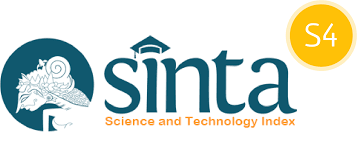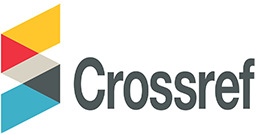Pertumbuhan dan Kandungan Vitamin C Tanaman Kangkung Darat (Ipomoea reptans Poir) pada Media Zeolit dengan Penambahan Asam Humat
Abstract
Ipomoea reptans Poir is the most favoured vegetable that mostly known by the people because in addition having good nutrition content, it is one type of vitamin C good source other than fruits. Vitamin C is an antioxidant which is required by the body to maintain the immune of body from the damaging effect of free radicals. The addition of organic compound in the form of humic acid that has a complex structure with high molecular weight and contains an active group that can increase the growth and productivity of plants. The high availability of nutrients require a carrier such as zeolite. Zeolite is a silicate mineral which have a high cation exchange capacity (CEC) (varying between 80-180 meq/100g). The addition of zeolite as a carrier is expected to increase the production of food crops such as corn. This study aimed to know the effect of humic acid with zeolite growth media for the growth and vitamin C content in Ipomoea reptans Poir and also and to determine the concentration of humic acid that most effect to the growth and vitamin C content in Ipomoea reptans Poir. The research was conducted at the Laboratory of Plant Physiology and Greenhouse, Faculty of Biology, Jenderal Soedirman University, Purwokerto by using experimental methods. The research was conducted from January 2019 to March 2019 with using completely randomized design (CRD). The parameters were observed in this study are the number of leaves, plant fresh weight, dry weight of plants, and vitamin C content. The data were analyzed by analysis of variance at the level of 95% and 99%, then following by analytical analysis BNT 95%. The results of this research showed that the addition of humic acid with a concentration of 4 g.kg-1 zeolite growing media can increase Ipomoea reptans Poir growth and the addition of humic acid to the zeolite growth media cannot increase the vitamin C content of Ipomoea reptans Poir.
References
Andarwulan, N. & Koswara, S., 1992. Kimia Vitamin. Jakarta: Rajawali Press.
Ayuso, M., Hernandez, T., Garcia, C. & Pascual, A.J., 1996. A Comparative Study Of The Effect On Barley Growth Of Humic Subtances Extracted From Municipal Wastes And From Traditional Organic Material. J sci food agric, 72:493-500.
Baldotto, M.A. & Baldotto , E.B., 2013. Gladiolus Development In Response To Blub Treatment With Different Concentrations Of Humic Acids. 60(1):138-42.
Cresna, Mery, N., & Ratman., 2014. Analisis Vitamin C Pada Buah Pepaya, Sirsak, Srikaya Dan Langsat Yang Tumbuh Di Kabupaten Donggala. J. Akademika Kim. 3(3): 346-353.
Davey, M.W., Kenis, K. & Keulemans, J., 2006. Genetic Control of Fruit Vitamin C Contents. Plant Physiology , 142:343-51.
Dicosmo, F. 1989. Tissue Culture Secondary Metabolism. Toronto: Bio International Inc.
Gardner, P., Frankin , B.R., Pearce & Roger, L.M., 2007. Fisiologi Terjemahan Oleh Herawati, Susilo. Jakarta: UI.
Hardjowigeno, S., 2003. Ilmu Tanah Ultisol. Jakarta: Akademika Pressindo.
Ihdaryanti, M.A., 2011. Pengaruh Asam Humat Dan Cara Pemberiannya Terhadap Pertumbuhan Dan Produktivitas Tanaman Padi (Oryza sativa). Bogor: Institut Pertanian Bogor.
Irawati & Salamah , Z., 2013. Pertumbuhan Tanaman Kangkung Darat (Ipomoea reptans Poir) Dengan Pemberian Pupuk Organik Berbahan Dasar Kotoran Kelinci. Jurnal Bioedukatika, 1(1):1-96.
Kurniawan, M., Munifatul, I. & Yulita, N., 2010. Kandungan Klorofil, Karotenoid, dan Vitamin C pada Beberapa Spesies Tumbuhan Akuatik. Buletin Anatomi dan Fisiologi, 18(1):28-40.
Manitto, P. (1981). Biosintesis Produk Alami.Terjemahan : Koensoemardiyah. Semarang: Press Semarang.
Naidu, K.A., 2003. Vitamin C In Human Health And Disease Is Still A Mystery An Overview. Nutrition Journal, 2(7):1-10.
Noviati, A., Yulita, N. & Nintya, S., 2012. Respon Pertumbuhan dan Produksi Senyawa Antioksidan pada Kalus Hibiscus sabdarifa L. dari Eksplan yang Berbeda Secara in vitrio 22(1): 25-29.. Jurnal Sains dan Matematika, 1(22):25-29.
Ramawat, K.G. 1999. Production in culture: optimation. In Ramawat,K.G. and J.M. Merillon. (eds). Biotechnology Secondary Metabolites.New Hampchire: Science Publisher, Inc.
Savitri , A., 2016. Tanaman Ajaib. Basmi Penyakit dengan TOGA (Tanaman Obat Keluarga). Depok: Bibit Publisher.
Sembiring, J.V., Nelvia, N. & Yulia, A.E., 2016. Pertumbuhan Bibit Kelapa Sawit (Elais guineensis Jaca) Di Pembibitsn Utama Pada Medium Sub Soil Ultisol Yang Diberi Asam Humat Dan Kompos Tandan. Jurnal Agroteknologi , 6(1):25-32.
Senda, S.P., Saputra, H., Sholeh, A. & Rosjidi, M., 2009. Prospek Aplikasi Produk Berbasis Zeolit Untuk Slow Release Subtances (SRS) Dan Membran. Artikel Badan Pengkaji Dan Penerapan Teknologi Indonesia,ISSN 1410-9891.
Suwardi, 1991. Pemanfaatan Zeolit Sebagai Media Tumbuh Tanaman. Tokyo: PPI-Jepang.
Suwardi, 2009. Teknik aplikasi zeolit dibidang pertanian sebagai bahan pembenah tanah. Jurnal Zeolit Indonesia, 8:33-38.
Valpuesta, V. & Botella, M.A., 2004. Biosynthesis Of L-Ascorbix Acid In Plants: New Pathway For An Old Antioxidant. Trends In Plants Science , 9(12):573-76.













